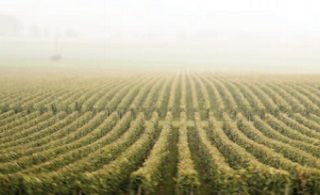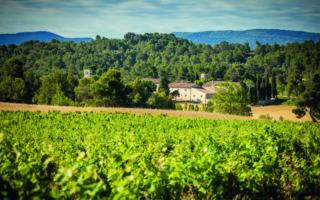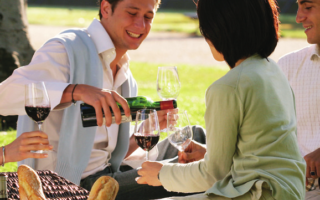Cahors wine
The wind of change
Cahors features amongst the oldest vineyards in France, dating back to the Gallo Roman era. Much appreciated by the French from early days, the wines rapidly gained an excellent reputation. In 1152, after fifteen years with Louis VII of France, Aliénor of Aquitaine, whom we all know and love; married Henry , Duke of Normandy, AKA Henry Plantagenet, subsequently King of England. She brought with her a dowry which included most of South and Western France. This sort of thing is always helpful for export business.
By the early thirteenth century, British engineers establishing a commercial waterway for the river Lot brought what they called the ‘black wine of Cahors’ to London. Other early exports were to Scandinavia, and to Russia, where the wine was used for liturgical purposes by the orthodox church. Cahors native Pope John XXII, who moved to Avignon in 1316, planted the papal vineyards with Cahors vines in the Rhône valley. Interestingly enough, wine and religion have always made good bedfellows. It did after all give the peasants something to do, offering not only a form of early social welfare, but also a reasonable economic benefit for the church.
The conventional routes for all South West wine transport were the rivers of the Dordogne, Lot, Tarn, and Garonne , which naturally all ended up at Bordeaux. In spite of ongoing disputes with jealous Bordeaux merchants who viewed Cahors as a serious rival, and indeed blended it to beef up their lighter weight production, the export market flourished. By the first half of the 14th century , wines from the Quercy region represented half of all shipments from Bordeaux.
By the 17th century, with the Lot truly navigable, Cahors was flowing in the smart courts of Europe. The black wine caught on with the French merchant navy whose officers were served with it, whilst the other ranks had to make do with Bordeaux. Very much later, when the French took Algeria from the Ottomans in 1830 a similar tradition was followed, Cahors being the wine of predilection in the officers mess. Little did the Lot farmers then realize that by 1870 the French colonials were setting up a serious wine rival.
To be sure, it was pretty hefty stuff. Monsieur Jullien, writing in 1816, has the following comments:
“ The black wines are made with the Auxerrois grape: They combine a very deep colour, a good flavour, and plenty of ‘guts’ ………..they make a point of baking a proportion of the grapes in the oven, or bringing to the boil the whole of the vintage……..The merchants do not stop here……they blend with the must a distillation at a strength of some 29 degrees which they add in the proportion of…even a third according to the quality (!) that they wish to produce.
( If you want to try a modern day version of the Black Wine, call by Jean Luc Baldès, at Clos Triguedina, Vire sur Lot. Planted in 1830 by Etienne Baldès, and now cherished by the eighth generation, this is undisputably one of the great vineyards of the appellation. This wine is outstanding and will set you back € 25 – € 30.)
Post revolution problems in the former grand estates, war with England, and economic blockades in the early 1800’s, capped the growth of the vineyard until the 1850’s. Then, quite suddenly a new lease of life appeared for Cahors in the form of a devastating disease called “oidium” which decimated Bordeaux vineyards. In Cahors, which miraculously escaped the attacks of this nasty parasitic mushroom, planting increased, the vineyard expanded by 50%, and prices rocketed to boot. This was the prosperous heyday of Cahors. Look at the fine mid 19th century buildings nestling among today’s vines. Construction funds came from healthy vines. But as every farmer knows only too well, ‘the Lord giveth, and the Lord taketh away.’ Catastrophe was only just around the corner.
Imported in 1865 with American plants in error, the devastating parasitic little bug called phylloxera set its way to munching through half of the French vineyards. Cahors, with 58,000 hectares under vine, was this time not spared. In just five years from 1877 the vineyard was devastated. As if this were not enough to contend with, the arrival of the railways smashed a whole community of river freight transporters and enabled the growers down south to send their warmer climate, high yielding grape varieties to Bordeaux for blending in place of Cahors. By 1882, a certain Guillaume Geoffroy was the last to save cuttings of the Lot pre – phylloxera auxerrois vines at the Clos de Gamot. His descendants are still there today, still passionate about their vines. Give them a visit at Prayssac, and wonder at vines over 100 years old.
By the 1880’s France was anyway entering a period of economic slump. In Cahors they had difficulty in finding suitable bug resistant rootstock to graft the auxerrois grape. Other varieties were used of inferior quality. The auxerrois grape did not take happily to standard solutions.
The same time saw a massive depopulation of the countryside. In spite of having a nevertheless substantial 28,000 hectares of vines in the whole of the Lot, many were producing inferior wines. Cahors was losing its reputation whilst the Languedoc vineyards were flourishing, and by 1930 wine of good quality was coming over from Algerian vineyards to steal some of the market that had traditionally been for Cahors.
[mrb]
Fortunately the influence of centuries of tradition and the downright stubbornness of the old Cahors families refused to let the vineyard die. But it was not until the post war fifties that the economic situation permitted renewed hope. Once again, nature took a hand. You would think that the exceptional frost in 1956, which reduced the vineyard to a mere 1% of its former area would have finally rung the knell for Cahors. However, growers once again persevered, and in the sixties, now with a mere 300 hectares, Cahors benefited from the new found consumer affluence and interest in quality wine. Stocks were insufficient to meet the demand. The roller coaster of the Lot’s prime wine producer continued.
Cahors was unable to get in on the act when the first appellations were granted in 1935. The intermediate VDQS status was however granted in 1951, which defined the geographical limits of the vineyard. With a certain amount of help from one Georges Pompidou, native of Cajarc, President of France in 1969, Cahors achieved full appellation status in 1971. Today, it is the largest of the South West French vineyards.
Appellation status hardly brought overnight success. Flushed with their new found status, growers went in for a massive programme of over planting, over production, and, naturally enough over pricing. Growers were caught out by consumers who were less keen to dig deep into their pockets for this new appellation. Nature again intervened with three years of poor weather, and hard to sell stocks of second rate wine accumulated in the cellars.
By 1980, and chastened, once again, by the ups and downs of previous decades, the growers of Cahors, then with 1,783 hectares to manage, set about hauling the appellation back up to its former glory. In the last twenty years, the vineyard has once again doubled in size to a current 4,400 hectares, though much lower yielding than hitherto thanks to appellation controls. The fight is on to persuade 472 owners to come under the quality banner. Enormous progress has already been made, but dissention still rocks the ranks of producers.
What is it that makes a top quality wine?
Firstly, a great grape variety, harvested at luscious, ripe maturity.
Secondly, a geologically acclaimed soil , which for reasons as yet unknown, affiliates to perfection with that variety of grape.
Thirdly, a committed producer who will dedicate him (or her)self to a vinification process at the height of his art.
Cahors scores pretty well on the first two points; the challenge lies in the third.
Ask Jancis Robinson, still the world authority on grape varieties, about the malbec grape. Also known as Cot, or Auxerrois because the French don’t like to make it easy when it comes to wine. Malbec is the third largest grape variety in Argentina, and substantially installed in Chile. The younger generation outside France, unfortunately for Cahors, are more likely to be quaffing South American Malbec than a nice Cahors, unaware of the link. In spite of giving the Malbec a rating of ‘medium quality’ she goes on to say that:
‘on the higher rugged limestone vineyards of Cahors….Auxerrois, pre phylloxera, made Cahors reputation as the black wine….today the wine comes mainly from the richer vineyard land down by the river Lot; it consists of a minimum of 70% cot blended chiefly with Merlot and Tannat, and is closer to a slightly more fiery Côtes de Blaye than the prototype Cahors”
Note the immediate connection between the grape and the ‘terroir’ where it is grown.
The third point is the key to the future of Cahors.
By the simple expedient of favouring the demands of young winemakers in the post appellation rush to plant increased acreage in Cahors, the vineyard now benefits from a substantial amount of new blood. Many are converts from other farming converted into wine growers, and questioning traditional ways of doing things. Others are outsiders to the old regime, such as Alain– Dominique Perrin, former boss of Cartier, who brought modern marketing and export ideas as well as substantial investment to the Château Lagrezette. It is symptomatic of the current divisions over the way forward, that he has recently resigned from the Association of ‘Seigneurs’ of Cahors. This was set up in the eighties to differentiate the quality image of the the top producers from those who continued to produce the very ordinary ‘Carte Noir’ production.
How else do you explain the fact that a Cahors sold for less than € 5 is very different from a Cahors sold for € 25? This is the problem of all French wines: unless you understand that the appellation gives you a clue to its flavour, the constituent grape varieties, and its location. A quality charter it isn’t. Neither can it tell you how it is made, for instance, whether or not it is matured in oak.
Now a farmer may treat his wine as a cash crop, harvest it, ferment it and sell it to a ‘négotiant/merchant’ for maybe € 1.00 or so per litre. The négociant will take it away in his tanker, blend it with other wine from the area, put a smart label on it, and hey presto, there is your under €5 Cahors “Carte Noire” on the grocery shelves. It is not often very pleasant to drink and puts off many first time tryers of the Cahors appellation. There is a market for this product, but it doesn’t please growers who want to put a highly superior product on the market, to compete internationally.
There are plenty of growers trying to address this problem, and not only in Cahors. To many, the answer seems to be the clever idea they had in Bordeaux in the 19th century. Why not find the best areas of soil which consistently seem to produce better wine, and produce a list of those owners? The Grand Cru system works a treat in Bordeaux: why not elsewhere? In Burgundy, they do it slightly differently, and of course it is incredibly more complicated. But why not a Premier Cru/Grand Cru system? It seems to work for Chablis.
Given the enormous changes in society, it is hardly surprising that the Grand Cru system which worked in Bordeaux in 1855, is considerably more difficult to achieve in the third millennium. Furthermore, nothing can be done without the approval of the INAO. The National Institute of Original Appellations. In Cahors, they have already proposed a Grand Cru system, and this has been turned down. René Renou, President of the wine section of INAO, ( yes there are cheeses and all sorts for them to deal with as well) says that the file has not been “ stuck in the cupboard”. In the meantime, Jean Marie Sigaud, president of the producers union of Cahors (what a job!) has set out his stall. Massive geological work has been undertaken to find out which are the best areas for the Cahors vineyard. A quality charter has been introduced by Pascal Verhaeghe ( Ch. Du Cèdre) and Bertrand Vigouroux (Ch. De Mercuès ) and supported by other members of the Seigneurs club. In 1999, 33 producers wanted to join, and 19 were accepted. In 2000, 19 accepted for 39 applications; in 2001, 45 applications.
Things are moving in Cahors. There is terrific value and wonderful wine to be found in this old French wine growing area. All you need to know is where to look.
© Anthony Nielson
Share to: Facebook Twitter LinkedIn Email
More in aquitaine, burgundy, businesses, chateau, land, wine, work
Leave a reply
Your email address will not be published. Required fields are marked *



